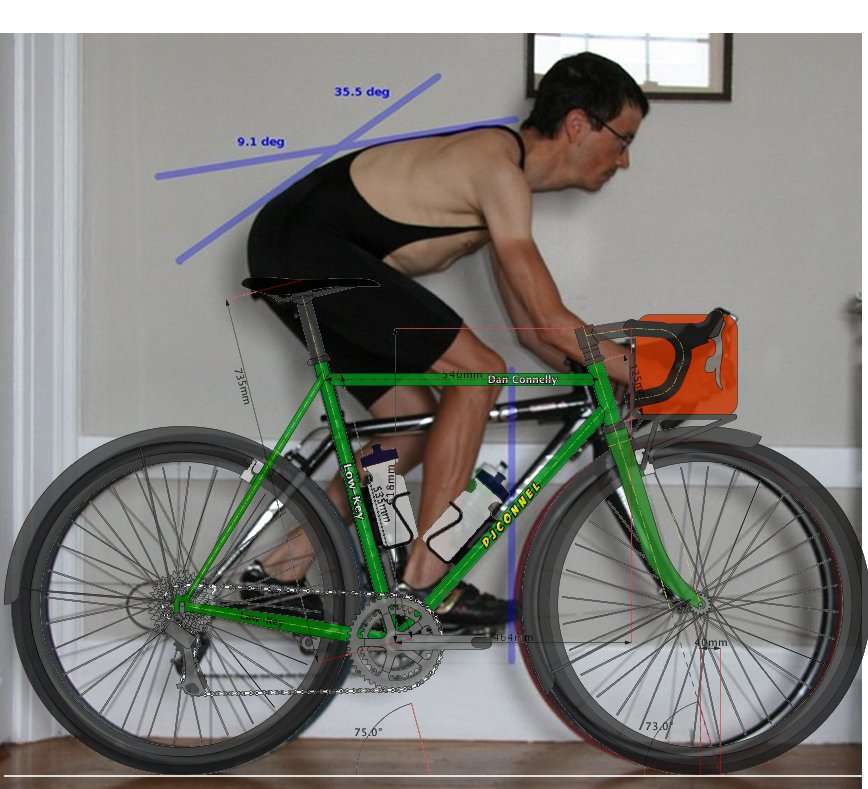Playing with BikeCad
I've been playing around with BikeCad, thinking about randonneuring bike designs. I've been fascinated with randonneuring bikes for a few years now, since I started reading Bicycle Quarterly. They seem an excellent option for a wide range of riding, including commuting to work, since a little carrying capacity goes a long way and having a handlebar bag would be super convenient for all sorts of things, liberating me from carrying a backpack for my work clothes, for example, and allowing me to carry more clothing option on certain rides. Fatter tires would be quite nice on the rough roads often encountered around here, and the rolling resistance of performance-oriented 650b/42mm tires has been proven in tests published in Bicycle Quarterly to be quite acceptable. Additionally, Cara wants to do a loaded tour, and while a randonneuring bicycle isn't optimized for a loaded tour, it's far better for that purpose than a traditional racing bicycle.
BikeCad is a wonderful tool for geometry tinkering since it handles all of the self-consistency issues, balancing microscopic parameters like tube angles and lengths with macroscopic variables like reach, stack, and trail. It's an amazing piece of work, and the pro version is widely used by small-scale custom frame builders.
To help with the geometry determination, I superposed a screen shot from BikeCad onto a photo I took of my position a few years ago. I flipped the photo to match the BikeCad camera position (this can be changed in the Pro version). I set the scales to match the tire diameter: BikeCad reported the tire diameter for the bike (670 mm) and I knew the value from my bike based on rollout tests (671 mm). Curiously the 650B wheels with 42 mm tires end up very closely matched to 700C wheels with 25 mm tires.
Here's the result:

The handlebars in the BikeCad model are a bit of a strange shape (this is adjustable), but at the time I was running my brake hoods on the Fuji fairly high, and curiously my bike design ended up with the brake hoods in approximately the same position. The new bike, however, offers a much higher position on the tops. Despite a much roomier design, the position on the hoods on the two bikes would be fairly similar. The position on the drops would be more relaxed on the randonneuring bike, though. That's fine: it's not designed for riding crouched in a pack of racers.
Still, randonneuring bikes traditionally have very little saddle-to-bar drop, and this one still has a substantial one. Is this just a cultural/retro thing, or is it due to rational basis? Honestly I can see moving my hands up a few cm but going to a drastically relaxed position makes little sense. Randonneuring bikes are still performance-oriented, just for longer distances and carrying small loads. There would be some compromise in loaded touring but I don't immediately foresee that being the primary application: there's no way I'd want to commute to work on a touring bike, so if I had to pick one, it would definitely be to compromise on the touring aspect.
Gravel racers are becoming popular but it seems randonneuring bikes are fairly well optimized for "adventure rides". The only issue there is the fenders, which can become clogged with dirt, but for gravel roads this isn't a big problem.
Randonneuring bikes have a lot of other historical associations, like generator hubs and Brooks saddles. Modern rechargeable LED lights are great: I have no desire for a generator hub (if anything, a generator would be useful for charging my electronics, not powering lights). And racing saddles work fine, even for ultramarathon races.
One aspect I'm willing to yield to retro-riders is downtube shifters. These work fine and are lighter and simpler. A fraction of a second lost in shifting is bad during mass-start races but for what I'd plan to use this bike for it's not an issue.
For brakes: cantilever brakes seem fine. Center-pulls exist which can wrap around fenders, but cantilevers are simple and light and by accounts I've read work well except for the possible issue of setting toe-in.
Anyway, it's quite possible my views on these aspects will evolve.

Comments